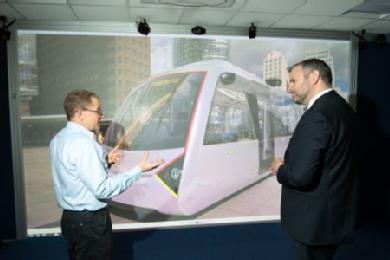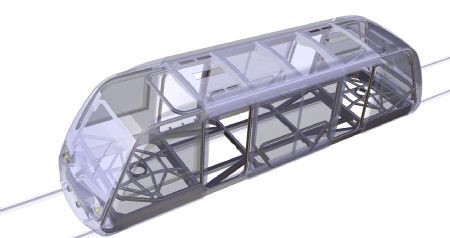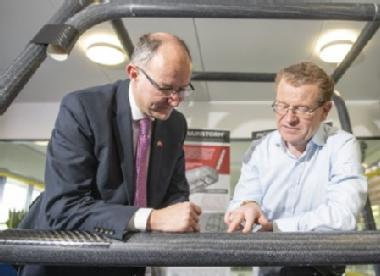WMG News
Minister shown how WMG literally weaved design of Very Light Rail – Braided structure lightweight
 WMG, at the University of Warwick, has worked with partners, to create a new design of incredibly lightweight Very Light Rail (VLR) vehicle frame which is weaved, or braided, from carbon fibre composites into a series of tubes to create a first prototype demonstrator frame. Parliamentary Under Secretary of State and Minister for Business and Industry Andrew Stephenson became one of the very first people to see the new design, outside of the research partnership, on a visit to WMG on 16th May.
WMG, at the University of Warwick, has worked with partners, to create a new design of incredibly lightweight Very Light Rail (VLR) vehicle frame which is weaved, or braided, from carbon fibre composites into a series of tubes to create a first prototype demonstrator frame. Parliamentary Under Secretary of State and Minister for Business and Industry Andrew Stephenson became one of the very first people to see the new design, outside of the research partnership, on a visit to WMG on 16th May.
 Working with the lightweight structural composite components company Far, and Transport Design International Ltd in Stratford upon Avon the demonstrator can be easily assembled by adhesive and simple welding.
Working with the lightweight structural composite components company Far, and Transport Design International Ltd in Stratford upon Avon the demonstrator can be easily assembled by adhesive and simple welding.
Dr Darren Hughes Associate Professor in Materials and Manufacturing at WMG at the University of Warwick said:
“Our BRAINSTORM VLR research partnership has achieved significant weight-saving, allowing VLR services to accommodate more passengers while reducing the energy required to propel the vehicle and the weight stress it will place on its rails and road surface.”
“The technology also ensures that the vehicle is tough for a long life in service, easily repairable when accidents happen and strong enough to protect the passengers on board.”
The innovative highly efficient very light weight approach consists of an underlying tubular spaceframe chassis which provides the body shell. In the first demonstrator frame the partners have produced they were able to keep the beams the same outside diameter but their wall thickness is tailored to give the optimum performance depending on where it will be used. This keeps the tooling costs low and allows for all the joining to be standardised through a combination of welding and adhesive bonding.
If any significant damage is caused to any individual beam through an accidental impact each damaged beam can simply be entirely replaced with a new one. Best of all the thermoplastic material is inherently recyclable.
 The whole moulding cycle has been shown to be capable of being reduced to less than five minutes, demonstrating the potential of this affordable process for high-volume applications. The braiding process is highly automated and with rates of over a mile a day of braided tubing.
The whole moulding cycle has been shown to be capable of being reduced to less than five minutes, demonstrating the potential of this affordable process for high-volume applications. The braiding process is highly automated and with rates of over a mile a day of braided tubing.
This braiding method also allows for a wide range of materials to be used. Almost any fibres (carbon, glass and aramid) can be combined with a huge range of thermoplastics, from low cost Polypropylene to high end Polyether ether ketone (PEEK) to create a material that suits the given application
Lyndon Sanders Director and General Manager of Nottingham based lightweight structural composite components company Far said:
“The BRAINSTORM Project feels like a real step forward to the team at Far Composites. Being able to tap into the industry experience of TDI to hone the principle of a new type of body structure for mass transit applications was great. Add to that the collaborative working with Composites Braiding and WMG to turn that thinking into a physical demonstrator to show what it would be like in practice was really powerful. Now it’s more than a good idea, now it’s an eye opener for industry players who can see it, touch it and even pick it up.”
ENDS
20 MAY 2019
Note for Editors:
High-res images available, please credit The University of Warwick:
The design of the frame with some other sections attached
https://warwick.ac.uk/services/communications/medialibrary/images/april2019/frame-cb1-2.jpg
Dr Darren Hughes (right) showing Lyndon Sanders Director and General Manager of Far (left of picture) the braiding pattern on the frame
https://warwick.ac.uk/services/communications/medialibrary/images/april2019/train_2_jpeg.jpg
Dr Darren Hughes Associate Professor in Materials and Manufacturing at WMG at the University of Warwick (left) showing Parliamentary Under Secretary of State and Minister for Business and Industry Andrew Stephenson (right of picture) all the design stages of the VLR vehicle
https://warwick.ac.uk/services/communications/medialibrary/images/may2019/brainstorm_pic.jpg
The frame with less attached
https://warwick.ac.uk/services/communications/medialibrary/images/april2019/frame-cb5-1.jpg
Another view
https://warwick.ac.uk/services/communications/medialibrary/images/april2019/frame-cb2-1.jpg
A further view
https://warwick.ac.uk/services/communications/medialibrary/images/april2019/frame-cb9-1.jpg
The Full list of partners on the project are: WMG at the University of Warwick, the UK's Governments innovation agency Innovate UK, Far composites, Composite Braiding ,and Transport Design International Ltd in Stratford upon Avon
For further information please contact:
Alice Scott
Media Relations Manager – Science
University of Warwick
Tel: +44 (0) 2476 574 255 or +44 (0) 7920 531 221
E-mail: alice.j.scott@warwick.ac.uk
